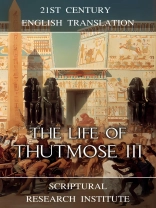Thutmose III was the king of Egypt between circa 1458 and 1425 BC, after inheriting the throne from his father c and his aunt Hatshepsut, however, after Hatshepsut died Thutmose III claimed to have been the king of Egypt throughout Hatshepsut’s reign, meaning his regal years began circa 1479 BC when his father Thutmose II died. This attempt to erase Hatshepsut as a king of Egypt was likely not personal, as he did not attempt to usurp her authority during his life, but more likely an attempt to restore the respect for the kingship that appears to have been lost while Hatshepsut was on the throne. The graffiti of Hatshepsut having sex with a man, found near her mortuary temple clearly shows that she was not respected the way the previous god-like pharaohs had been, and Thutmose III was almost certainly trying to erase was many Egyptians viewed as a distasteful episode of their history. Ironically, her mortuary temple is viewed as one of the greatest architectural monuments of the New Kingdom and served as the bases of all later mortuary temples of the New Kingdom.
Thutmose III did not attempt to erase Hatshepsut’s existence from Egyptian history, just her kingship, and she was still spoken of fondly as the ‘queen’ and ‘favorite wife of Thutmose II.’
It is accepted that he was only 2 years old when his father died and he became king in 1479 BC, although Hatshepsut held power as king until she died in 1458 BC. The two-year-old Thutmose III’s reign was established by Queen Hatshepsut over the objections of other claimants, as, she claimed that her husband Thutmose II had wanted Thutmose III to become king. Her reasons are not clear, and it is debated whether she was simply trying to seize power for herself and using her two-year-old nephew and step-son as a pawn, or following the legitimate wishes of her husband. Even her gender identity seems to have been in question, as there is evidence that she took her sister Iset, Thutmoses III’s mother, as her great royal wife and queen. This may have also been to protect Thutmose III, as Iset could claim the co-regency if something happened to her, however, she does appear to have lived as a man, treating Thutmose III as her own son. Whether this behavior was an affectation due to the male-dominated culture they lived in, or a genuine male-identity may never be known, however, she is claimed as a hero to feminists and transgender-people today.
Her reign seems to have been one of contracting frontiers, as Egypt appears to have lost control of Syria early in her reign, which Thutmose III quickly reversed, launching an invasion of Syria within his first year on the throne. This was the legionary Siege of Megiddo, against the king of Kadesh and his Syrian allies, inscribed in detail in the Annals of Thutmose III at Karnak. The details of the battle inscribed at Karnak, were copied from Thutmose III’s scribe Tjaneni’s journal, and is a far more detailed account than the subsequent list of battles and plunder taken during Thutmose III’s subsequent invasions of Northern Canaan and the Mitanni Empire in modern Syria, or his campaign against the Nubians.












